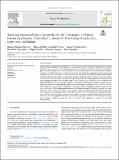Por favor, use este identificador para citar o enlazar a este item:
http://hdl.handle.net/10261/334329COMPARTIR / EXPORTAR:
 SHARE SHARE
 CORE
BASE CORE
BASE
|
|
| Visualizar otros formatos: MARC | Dublin Core | RDF | ORE | MODS | METS | DIDL | DATACITE | |

| Título: | Exploring entomopathogenic nematodes for the management of Lobesia botrana (Lepidoptera: Tortricidae) in vineyards: Fine-tuning of application, target area, and timing |
Autor: | Campos-Herrera, Raquel CSIC ORCID ; González-Trujillo, María del Mar CSIC ORCID; Vicente-Díez, Ignacio CSIC; Carpentero, Elisabeth; Puelles, Miguel CSIC ORCID CVN; Vaquero Jiménez, Elisabet CSIC; Čepulyte, Rasa | Palabras clave: | Adjuvants European grapevine moth Grapevine Heterorhabditis Steinernema Overwintering |
Fecha de publicación: | dic-2023 | Editor: | Elsevier | Citación: | Crop Protection 147: 106392 (2023) | Resumen: | Lobesia botrana (Lepidoptera: Tortricidae) is a crucial grapevine pest worldwide. Expanding the available biocontrol agents can provide new management strategies compatible with organic viticulture. Entomopathogenic nematode (EPN) potential as a biocontrol agent was demonstrated against various developmental stages of L. botrana. For its field application, we hypothesised that by selecting the best combination of EPN-adjuvant and identifying the best area/timing for their application, we will secure their effective implementation against L. botrana. The aim of this study was to determine the best ecological scenarios for their use against L. botrana. We investigate three EPN species naturally occurring in Riojan vineyards: Steinernema feltiae, S. carpocapsae, and Heterorhabditis bacteriophora. We evaluated (i) EPN viability, infectivity, and adherence on leaves combined with adjuvants (Multi-Us, Maximix, Dash HC, Nu-Film-17, and Adrex), (ii) EPN biocontrol against L. botrana larva on leaves and grapes and damage reduction, and (iii) EPN efficacy against L. botrana at 22°, 15°, and 10 °C. Overall, all the adjuvants were compatible with the EPN, except Adrex with Heterorhabditis bacteriophora. Compared with the no application, EPNs (steinernematids) alone or with Maximix increased L. botrana L3 mortality on grapes and leaves, thereby reducing the damage. Pupal mortality caused by steinernematids EPN (alone or with Maximix) decreased with temperature, from ∼60% at 22 °C to <30% at 10 °C. Overall, steinernematids EPN (alone or with Maximix) applied against L. botrana on leaves, grapes, or trunks reduced the damage and increased insect mortality. This study suggests the best-case scenario for the application of EPNs is at sunset during late spring/early autumn at mid-temperatures (22 °C-15 °C). Further field validation is necessary for their full implementation. | Versión del editor: | https://doi.org/10.1016/j.cropro.2023.106392 | URI: | http://hdl.handle.net/10261/334329 | DOI: | 10.1016/j.cropro.2023.106392 | ISSN: | 0261-2194 |
| Aparece en las colecciones: | (ICVV) Artículos |
Ficheros en este ítem:
| Fichero | Descripción | Tamaño | Formato | |
|---|---|---|---|---|
| 82-Campos-Herrera et al. 2023 Crop Protection.pdf | 4,99 MB | Adobe PDF |  Visualizar/Abrir |
CORE Recommender
SCOPUSTM
Citations
1
checked on 11-may-2024
WEB OF SCIENCETM
Citations
1
checked on 24-feb-2024
Page view(s)
47
checked on 17-may-2024
Download(s)
21
checked on 17-may-2024
Google ScholarTM
Check
Altmetric
Altmetric
Este item está licenciado bajo una Licencia Creative Commons

